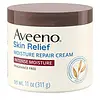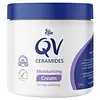What's inside
What's inside
 Key Ingredients
Key Ingredients

 Benefits
Benefits

 Concerns
Concerns

 Ingredients Side-by-side
Ingredients Side-by-side

Water
Skin ConditioningGlycerin
HumectantDistearyldimonium Chloride
Petrolatum
EmollientIsopropyl Palmitate
EmollientCetyl Alcohol
EmollientDimethicone
EmollientAvena Sativa Kernel Flour
AbrasiveAvena Sativa Kernel Oil
Skin ConditioningAvena Sativa Kernel Extract
AbrasiveButyrospermum Parkii Butter
Skin ConditioningCaprylyl Glycol
EmollientPhenoxyethanol
PreservativeSteareth-20
CleansingSodium Chloride
MaskingWater
Skin ConditioningGlycerin
HumectantParaffinum Liquidum
EmollientPetrolatum
EmollientCetearyl Alcohol
EmollientDimethicone
EmollientCeteareth-20
CleansingStearic Acid
CleansingGlyceryl Stearate
EmollientSqualane
EmollientLaureth-3
EmulsifyingMethylparaben
PreservativeDichlorobenzyl Alcohol
AntimicrobialSodium Lauroyl Lactylate
EmulsifyingNiacinamide
SmoothingCeramide AP
Skin ConditioningCeramide NP
Skin ConditioningCeramide EOP
Skin ConditioningPhytosphingosine
Skin ConditioningCholesterol
EmollientXanthan Gum
EmulsifyingCarbomer
Emulsion StabilisingEthylhexylglycerin
Skin ConditioningWater, Glycerin, Paraffinum Liquidum, Petrolatum, Cetearyl Alcohol, Dimethicone, Ceteareth-20, Stearic Acid, Glyceryl Stearate, Squalane, Laureth-3, Methylparaben, Dichlorobenzyl Alcohol, Sodium Lauroyl Lactylate, Niacinamide, Ceramide AP, Ceramide NP, Ceramide EOP, Phytosphingosine, Cholesterol, Xanthan Gum, Carbomer, Ethylhexylglycerin
Ingredients Explained
These ingredients are found in both products.
Ingredients higher up in an ingredient list are typically present in a larger amount.
Dimethicone is a type of synthetic silicone created from natural materials such as quartz.
What it does:
Dimethicone comes in different viscosities:
Depending on the viscosity, dimethicone has different properties.
Ingredients lists don't always show which type is used, so we recommend reaching out to the brand if you have questions about the viscosity.
This ingredient is unlikely to cause irritation because it does not get absorbed into skin. However, people with silicone allergies should be careful about using this ingredient.
Note: Dimethicone may contribute to pilling. This is because it is not oil or water soluble, so pilling may occur when layered with products. When mixed with heavy oils in a formula, the outcome is also quite greasy.
Learn more about DimethiconeGlycerin is already naturally found in your skin. It helps moisturize and protect your skin.
A study from 2016 found glycerin to be more effective as a humectant than AHAs and hyaluronic acid.
As a humectant, it helps the skin stay hydrated by pulling moisture to your skin. The low molecular weight of glycerin allows it to pull moisture into the deeper layers of your skin.
Hydrated skin improves your skin barrier; Your skin barrier helps protect against irritants and bacteria.
Glycerin has also been found to have antimicrobial and antiviral properties. Due to these properties, glycerin is often used in wound and burn treatments.
In cosmetics, glycerin is usually derived from plants such as soybean or palm. However, it can also be sourced from animals, such as tallow or animal fat.
This ingredient is organic, colorless, odorless, and non-toxic.
Glycerin is the name for this ingredient in American English. British English uses Glycerol/Glycerine.
Learn more about GlycerinPetrolatum is more commonly known as petroleum jelly. It is created by mixing waxes and mineral oils.
This ingredient is effective at reducing water loss by 99%. This is because it is an occlusive. Occlusives create a hydrophobic barrier on the skin to prevent evaporation. This property makes it great for hydrating dry skin.
Pro tip: Use occlusives, such as this ingredient, on damp skin for the best results.
The quality or origin of petrolatum is only known when disclosed by the brand. Most cosmetic petrolatum has gone through several purification stages.
Another benefit of occlusives is it protects your skin against infection or allergies.
Petrolatum may not be safe for fungal-acne. Studies show mineral oil / petroleum leads to the growth of M. Furfur, a type of yeast.
Learn more about PetrolatumWater. It's the most common cosmetic ingredient of all. You'll usually see it at the top of ingredient lists, meaning that it makes up the largest part of the product.
So why is it so popular? Water most often acts as a solvent - this means that it helps dissolve other ingredients into the formulation.
You'll also recognize water as that liquid we all need to stay alive. If you see this, drink a glass of water. Stay hydrated!
Learn more about Water